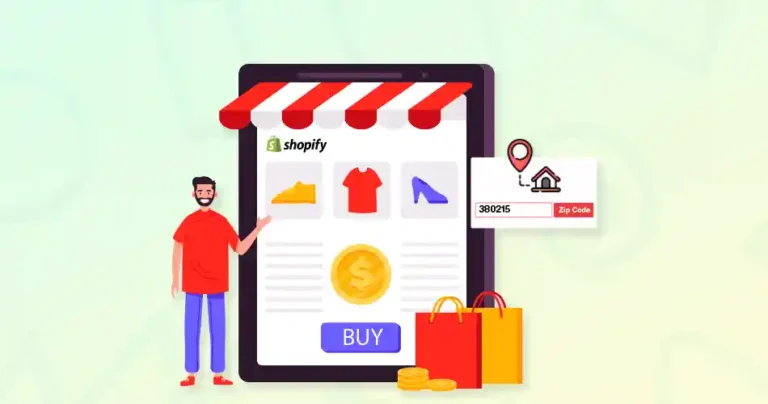A simple and smooth shopping experience is important for every online store. When customers add items to their shopping list, they expect everything to be ready when they return. But if their location details, like zip codes, are missing, they have to enter them again. This extra step can be frustrating and might even make them leave without buying. To fix this, many store owners hire Shopify Experts Developers to improve their shopping lists.
The basic Shopify shopping list does not save location details, which makes the checkout process slower. A fast and easy checkout keeps customers happy and increases sales. By adding zip codes to shopping lists, store owners can make shopping more convenient for their customers.
With expert help, Shopify stores can be updated to save zip codes in shopping lists. This small change makes shopping easier. It cuts down extra steps and helps customers finish their purchases without frustration. In this blog, we will explain how this works and why it is useful for your store.
What are Advanced Shopping Lists?
An advanced shopping list is an enhanced version of the standard wishlist. A basic wishlist lets customers save items for later, but an advanced shopping list does more. It helps manage large lists, track availability, and add specific quantities or preferences.
These lists simplify order management. Customers can quickly revisit their saved items. Merchants can track customer preferences. This helps predict demand and improve inventory planning.
Advanced shopping lists provide a better and more personal shopping experience than basic lists.
Why are Zip Codes Important?
Zip codes are important for eCommerce. They help with shipping and managing inventory. Here’s how they impact the shopping experience:
- Real-time Shipping Quotes: Zip codes help Shopify figure out the right shipping costs at checkout. Customers can enter a zip code to get real-time shipping quotes. This way, they know the delivery charges before finishing their purchase. This removes unexpected shipping fees. It also helps customers make better choices.
- Inventory Management: Zip codes help send orders to the best warehouse or fulfillment center. This depends on where the customer is located. Shopify connects zip codes to specific warehouses. This way, it can send orders to the nearest fulfillment center. As a result, shipping times and costs go down.
- Local Delivery & Pickup: Zip codes are essential for offering local delivery or pickup options. Restricting these services to certain areas means only customers in specific zip codes can choose these options. This helps optimize your store’s logistics and offers a more localized service.
- Targeted Marketing: Zip codes provide key insights into customer behavior. You can use this information for targeted marketing campaigns. You can use zip code data to create special promotions, discounts, or local offers. This helps boost sales and connect with customers based on where they live.
Using zip codes in your shopping list system makes your Shopify store run better and be more friendly for customers. That leads to better order management and a smoother shopping experience.
For these benefits, you can have a consultation with our dedicated Shopify development company.
Prerequisites for Adding Zip Codes to Shopping Lists
To add zip codes to your advanced shopping lists in Shopify, make sure your store has the right tools and settings. These prerequisites lay the foundation for a seamless implementation and optimal functionality:
- Shopify Plan: To manage advanced shopping lists and customize checkout, you might need a higher-tier plan. Options include Shopify Plus or Advanced Shopify.
- Custom Scripts or Apps: Shopify doesn’t let you add zip codes to shopping lists. So, you might need custom scripts or third-party apps to help with this.
- Shipping Zones Configuration: Ensure your store has well-defined shipping zones. Zip codes will need to be associated with these zones to accurately calculate shipping rates and manage deliveries.
Meeting these requirements makes your store ready for zip code integration. This will improve customer experience and streamline operations.
Adding zip codes to your advanced shopping list on Shopify improves shipping accuracy. It also helps with location-based discounts and personalizes the shopping experience.
Step 1: Install a Shopping List App
Shopify does not offer a built-in advanced shopping list feature, so the first step is to install a shopping list app from the Shopify App Store. Some popular apps include:
- Wishlist Plus
- Smart Wishlist
- Wishlist
These apps let customers save products for later. They also have features like product recommendations and email notifications.
- Go to the Shopify App Store.
- Search for a shopping list or wishlist app of your choice.
- Install the app and configure it according to your needs.
Step 2: Create Custom Fields for Zip Codes
In order to add zip codes to the advanced shopping list, you will need to create custom fields in your shopping list app to store and process zip codes. If the app supports custom fields, you can add a field specifically for zip codes.
How to Create Custom Fields:
- Go to the App Settings: Navigate to the settings section of your installed wishlist app.
- Add Custom Field: Look for an option to create custom fields (this may be labeled as “Add Field,” “Custom Attributes,” or “Advanced Settings”).
- Field Type: Choose “Text” or “Number” as the field type for zip codes.
- Field Label: Name the field something like “Customer Zip Code” or “Shipping Zip Code.”
- Save the Changes: After configuring the field, save the changes.
If the app lacks this feature, you may need to use a third-party app or develop a custom solution. This can be done with Shopify’s Liquid templating language or the Shopify API.
Step 3: Set Up Zip Code Validation
To ensure that customers are entering valid zip codes, it’s important to set up validation rules. Zip codes vary by country or region. This step is key for a precise shopping experience.
- Zip Code Format: You can set rules to check if customers enter zip codes correctly. For example, use 5 digits for the US or 6 characters for Canada.
- Country Rules: If your store sells internationally, add zip code checks for the customer’s selected country at checkout.
- Error Handling: If a customer enters an incorrect or invalid zip code, provide an error message prompting them to correct it.
This step may require custom coding or using an app that supports zip code validation.
Step 4: Use Zip Codes to Offer Location-based Discounts or Shipping Rates
After setting up zip codes in your advanced shopping list, you can use them for location-based discounts or precise shipping rates.
Offering Location-based Discounts:
- Create Discount Codes: In the Shopify admin panel, create discount codes that apply to specific zip codes or shipping zones.
- Set Conditions: In the discount settings, make sure the discount activates only if the customer’s zip code matches a specific region.
- Promote Local Offers: Use saved zip codes in the shopping list. This helps you share discounts or offers based on where customers live.
Calculating Shipping Rates Based on Zip Codes:
- Define Shipping Zones: Go to Settings > Shipping and Delivery in your Shopify admin panel.
- Add Zip Codes to Zones: For each shipping zone, add the zip codes that correspond to specific regions you ship to. This allows Shopify to calculate the most accurate shipping rates at checkout.
- Custom Shipping Apps: Use third-party apps like Advanced Shipping Rules or Parcelify. These tools help you set shipping rules based on zip codes.
Step 5: Test Your Zip Code Integration
Once everything is set up, it’s crucial to test the integration before going live. Here’s how:
- Add Products to the Shopping List: Go to the customer-facing shopping list page and add products.
- Enter Zip Code: Ensure that customers can enter zip codes when saving products or proceeding to checkout.
- Check for Validity: Test the zip code field to ensure validation is working and that the system prompts users when the zip code is invalid.
- Test Discounts and Shipping: Check that discounts and shipping rates match the entered zip code.
Step 6: Monitor and Optimize
After your system is live, keep an eye on the following:
- Customer Feedback: Gather feedback from customers regarding the zip code functionality.
- Shipping Accuracy: Ensure shipping rates are calculated correctly based on zip codes.
- Conversion Rates: Monitor how well location-based discounts or offers work. Adjust them to improve results.
Adding zip codes to your advanced shopping list helps streamline shipping and discounts while creating a more personalized shopping experience.
By following these steps, you can easily integrate zip codes into your Shopify store, allowing customers to receive location-based offers. This also improves store management and efficiency. If you need assistance, hire dedicated Shopify experts from our team. They can help you set up everything seamlessly.
Why Add Zip Codes to Advanced Shopping Lists?
Adding zip codes to Shopify’s advanced shopping lists improves your online store’s functionality. This approach improves the customer experience with tailored options. It also helps merchants streamline operations and manage logistics better.
- Shipping Rates by Location: Merchants can discover shipping costs by linking zip codes to their shopping lists. This helps them consider the customer’s location. This ensures fair pricing and eliminates confusion during checkout.
- Personalized Offers: Zip codes enable merchants to deliver region-specific promotions and discounts. You can run a campaign focused on a specific area. This makes your offers more relevant and boosts conversion rates.
- Regional Inventory Management: Linking products to warehouses makes it easier to manage stock levels. This ensures customers see only items in their area. It reduces problems with backorders or delivery delays.
- Local Delivery Options: Zip codes are key for stores that offer local delivery or pickup. They help limit these services to eligible areas. This keeps things simple. It makes delivery or pickup easy for customers.
Merchants can use zip codes to create a more personal shopping experience. This also helps improve their logistics. Adding zip codes to shopping lists can greatly improve your Shopify store. It helps calculate shipping rates. It also offers targeted promotions and provides the best delivery options for customers.
Let’s Summarize
Adding zip codes to your Shopify advanced shopping list helps customers and store owners. It improves the shopping experience for everyone.
Use zip codes to personalize offers, simplify shipping, and target regions with the right promotions. Shopify doesn’t support zip codes in shopping lists by itself. But you can add this feature easily using third-party apps and custom solutions.
Using zip codes in your shopping list can help you manage stock, offer discounts, and adjust shipping rates. Need professional help with it? Then consult with us today!
FAQs on Zipcodes in Shopping Lists in Shopify
Q1. Can I set up region-specific shipping rates using zip codes?
Shopify allows you to set shipping rates based on zip codes by creating shipping zones. You can map zip codes to specific zones and offer different rates for each region.
Q2. How do I validate zip codes entered by customers?
You can validate zip codes in your custom fields or use third-party apps that check zip code formats. This helps customers enter valid postal codes according to their country’s specific rules.
Q3. Can I automate shipping rate calculation based on zip codes?
Sure! In Shopify, you can set up shipping zones and connect zip codes to them. This way, when customers check out, the system will calculate shipping rates based on their zip codes.
Q4. Can I offer local delivery options using zip codes?
Yes, zip codes can limit local delivery. They make sure that only customers in certain areas can choose local delivery as a shipping option.





